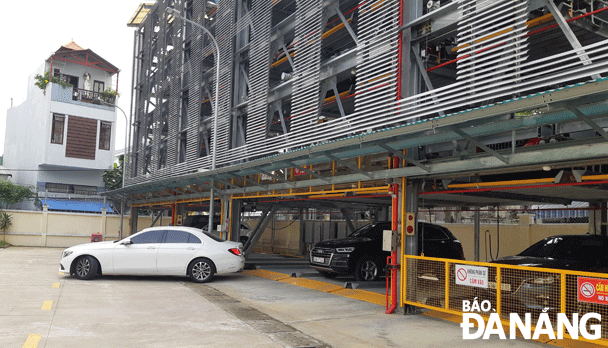Accelerating the construction of parking spaces in Da Nang
In August 2015, the Da Nang government made adjustments to the city’s master plan to enhance its transport network to 2020, with a vision to 2030 with the aim of building a combined total of 158 public parking spaces with an area of nearly 3.9 million square meters. However, the number of available spaces in the city has till date been lower than expected.
 |
| The first phase of the citys first automated parking space located at 255 Phan Chau Trinh in Hai Chau District has already completed and put into use. Photo: THANH LAN |
In the past 3 years from 2019 to 2021, Da Nang has built only 1 smart car parking space and 22 temporary parking lots, with a total usable area of 74,531 square metres which can accommodate 2,542 vehicles.
In June 2021, the Da Nang government approved the auction of land use rights for 13 land plots with a total area of 48,838 square meters for the purpose of appealing investments into the construction of public parking lots. Among land for auction are 5 plots in Hai Chau District, namely in 51A Ly Tu Trong, 10 Ly Thuong Kiet, 19 Le Hong Phong, a lot on Nguyen Van Linh Street and another one on Thai Phien Street.
However, the municipal administration has recently decided to remove a land lot on Nguyen Van Linh Street from the 13 land listings for auction.
Currently, there are 3 public car parking lots in each of Son Tra and Ngu Hanh Son districts and 2 others in Cam Le District. However, the newly-built parking spaces do not keep up with rapidly growing demand from local users, especially personal car owners. According to incomplete statistics, Da Nang is now home to close to 1 million cars, almost double the figure recorded in 2015. In addition, there are several thousands of vehicles entering Da Nang from other parts of country, causing an increase in parking demand.
Vehicles are seen parking on such main streets as Hung Vuong, Pasteur, Ong Ich Khiem, Le Duan, Quang Trung, Phan Chau Trinh, or in alleys in the districts of Hai Chau, Thanh Khe, Son Tra, Ngu Hanh Son and more, causing an obstruction to other road users .
Mr. Truong Bang Linh, the Director of the Da Nang Centre for Traffic Infrastructure Management said that, the agency built and put into use 5 temporary parking lots with a total usable area of 13,700 square meters in 2019, and 17 others with a total construction area of 55,531 square meters in 2020. In 2021 alone, a temporary parking lot is under construction in Cam Le District with a total area of 4,300 square meters, and it is scheduled to be delivered within December.
Since 2019, the municipal government has asked authorities at local level to install ‘No Parking" signs in their local alleys. In addition, in its efforts to deal with the problems of parking on roads that cause traffic obstruction, the municipal administration has issued odd-even parking regulations on local streets.
Mr. Nguyen Minh Huy, the Head of the Management Board of Traffic Work Investment and Construction Projects in Da Nang, said that the agency has approved the results of selection of contractors for the first phase of a parking project on Hai Phong Street. Four selected contractors are Phu Thanh Hung Company Limited, An Bao Phat Technical Service and Trading Company Limited, Tuyet Nga Company Limited, and Cotecom Joint Stock Company. They will work as a consortium to deploy this project, and Phu Thanh Hung Company will play a leading role.
Mr Nguyen Huu Cuong, the Chief of Office of the municipal Department of Transport, remarked that construction for a new temporary parking lot is underway in Da Nang, and another one will be built at the corner of the intersection of Thang Long and Pham Tu streets, near Nguyen Tri Phuong Bridge.
One more temporary parking lot will be built at 383 Cach Mang Thang Tam Street. In addition, the heed is paid on accelerating the construction of the second phase of the new parking garage at 255 Phan Chu Trinh Street and another one at 166 Hai Phong Street under the form of public-private sector cooperation. Financing a project through a public-private partnership can allow a project to be completed sooner or make it a possibility in the first place.
Reporting by THANH LAN – Translating by H.L